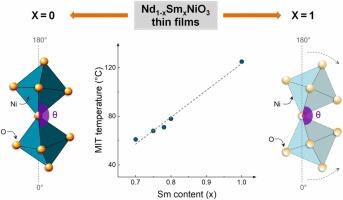通过改变Nd1-xSmxNiO3薄膜中Sm含量来调整钙钛矿镍酸盐的结构、光学和电学性能,用于太阳能热应用
IF 6.3
2区 材料科学
Q2 CHEMISTRY, PHYSICAL
引用次数: 0
摘要
稀土镍酸盐(RNiO3)是需要在特定温度下改变性能的创新应用中不可或缺的材料。这项研究引入了一种通过溅射和随后的空气退火来制备大规模Nd1-xSmxNiO3薄膜的新方法,绕过了稳定亚稳Ni³氧化态通常需要的极端氧压。对化学成分的精确控制可以对结构扭曲进行微调,从而产生量身定制的物理特性,包括转变温度。x射线衍射分析证实了钙钛矿结构,晶格参数与Nd-Sm组成呈线性相关。先进的表征技术,包括透射电子显微镜、能量色散x射线光谱学和电子能量损失光谱学,提供了对微观结构和氧化态的详细见解,而傅里叶变换红外光谱和电学测量揭示了金属-绝缘体转变(MIT)和热致变色行为。金属-绝缘体转变温度(TMI)为61 ~ 78℃,对应于Nd1-xSmxNiO3薄膜中Sm含量的变化范围为0.70 ~ 0.80。光谱椭偏进一步证明了介电性质的相变,这对光电应用至关重要。最后,Nd0.20Sm0.80NiO3薄膜显示出作为太阳能热应用的选择层的潜力。通过采用空气退火而不是200巴的高压氧退火,这种方法现在可以在大到平方米的表面上沉积,为设计具有定制功能的智能材料铺平了道路。本文章由计算机程序翻译,如有差异,请以英文原文为准。

Tailoring the structural, optical and electrical properties of perovskite nickelates through the Sm content variation in Nd1-xSmxNiO3 thin films for solar thermal applications
Rare-earth nickelates (RNiO3) are indispensable materials for innovative applications requiring property changes at specific temperatures. This study introduces a novel approach for fabricating large-scale Nd1-xSmxNiO3 thin films through sputtering and subsequent air annealing, bypassing the need for extreme oxygen pressures typically required to stabilize the metastable Ni³⁺ oxidation state. Precise control over the chemical composition enables fine-tuning of structural distortions, leading to tailored physical properties, including transition temperatures. X-ray diffraction analysis confirms the perovskite structure, with a linear correlation between lattice parameters and Nd-Sm composition. Advanced characterization techniques including transmission electron microscopy, energy-dispersive X-ray spectroscopy, and electron energy-loss spectroscopy, provide detailed insights into the microstructure and oxidation states, while Fourier-transform infrared spectroscopy and electrical measurements reveal a metal-insulator transition (MIT) and thermochromic behavior. The metal-insulator transition temperature (TMI) ranges from 61 to 78 °C, corresponding to Sm content variations from 0.70 to 0.80 in Nd1-xSmxNiO3 thin films. Spectroscopic ellipsometry further demonstrates phase transitions in dielectric properties, which is essential for optoelectronic applications. Lastly, the Nd0.20Sm0.80NiO3 thin film shows potential as a selective layer for solar thermal applications. By employing air annealing instead of high-pressure oxygen annealing at 200 bars, this approach now enables deposition on surfaces as large as a square meter, paving the way for designing smart materials with tailored functionalities.
求助全文
通过发布文献求助,成功后即可免费获取论文全文。
去求助
来源期刊

Journal of Alloys and Compounds
工程技术-材料科学:综合
CiteScore
11.10
自引率
14.50%
发文量
5146
审稿时长
67 days
期刊介绍:
The Journal of Alloys and Compounds is intended to serve as an international medium for the publication of work on solid materials comprising compounds as well as alloys. Its great strength lies in the diversity of discipline which it encompasses, drawing together results from materials science, solid-state chemistry and physics.
 求助内容:
求助内容: 应助结果提醒方式:
应助结果提醒方式:


